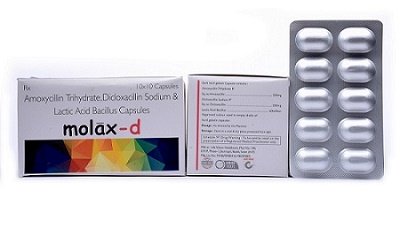Description
PHARMACOLOGY
1.AMOXYCILLIN
a.)Pharmacodynamics: –
Mechanism of Action: -Amoxycillin is a bactericidal drug. It is a Beta lactum antibiotic. It binds to the Penicillin binding protein in the cell wall of bacteria and inhibits the enzyme transpeptidase which is responsible for the transpeptidation reaction in peptidoglycan synthesis. It also activates the endogenous enzyme which degrades the peptidoglycan.These results in inhibition of protein synthesis and there by cell wall synthesis. Amoxycillin is active against gram positive and gram negative bacteria except penicillinase producing once.
2.DICLOXACILLIN
a.)Pharmacodynamics: – A semi synthetic narrow spectrum beta-lactam antibiotic of penicillin class, Penicillinase resistant Antibiotic.
Mechanism of Action of Dicloxacillin
Like other ?-lactam antibiotics, dicloxacillin acts by inhibiting the synthesis of bacterial cell walls. It inhibits cross-linkage between the linear peptidoglycan polymer chains that make up a major component of the cell wall of Gram-positive bacteria.
PHARMACOKINETICS
1.AMOXYCILLIN
- Absorption: – It is well absorbed after oral administration.
- Distribution: It is very widely distributed in the body.
- Metabolism: In significant metabolism.
- Excretion: It is excreted mainly through urine and small amount excreted in breast milk.
2.DICLOXACILLIN
- Absorption :Absorption after oral administration is rapid but incomplete, food delays absorption
- Distribution: Widespread, highest in kidneys & liver, CSF low
- Protein Binding: 96%
- Metabolism: Hepatic CYP3A4
- Excretion: Renal, feces
INDICATIONS:
- Respiratory tract Infections.
- Tonsillar abscess, otitis media, suppurative sinus infection, acute and chronic bronchitis, bronchi-ectasis, bronchopneumonia, pleu-risy, empyema, lung abscess, emphysema, bronchiolitis.
- Gynecological Infections.
- Septic abortion, puerperal infections, caesarean sections and other gynaeco-logical surgeries.
- Urinary tract Infections.
- Acute and chronic pyelonephritis, cystitis, urethritis.
- Skin and soft tissue Infections.
- Recurrent boils, carbuncles, impetigo, cellulitis and other infected dermatoses.
- Bone Infections.
- Osteomyelitis and septic arthritis.
- Serious Infections.
- Septicaemia, bacterial endocarditis, brain abscess and bacterial meningitis.













